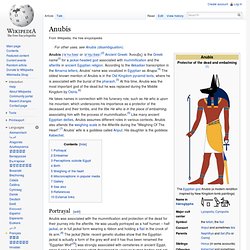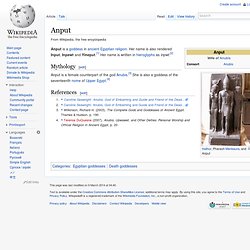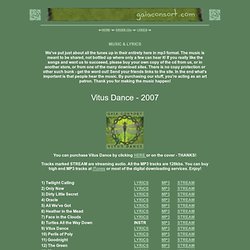

Beyond Beginner Wicca. Anubis. Anubis (/əˈnuːbəs/ or /əˈnjuːbəs/;[2] Ancient Greek: Ἄνουβις) is the Greek name[3] for a jackal-headed god associated with mummification and the afterlife in ancient Egyptian religion.

According to the Akkadian transcription in the Amarna letters, Anubis' name was vocalized in Egyptian as Anapa.[4] The oldest known mention of Anubis is in the Old Kingdom pyramid texts, where he is associated with the burial of the pharaoh.[5] At this time, Anubis was the most important god of the dead but he was replaced during the Middle Kingdom by Osiris.[6] He takes names in connection with his funerary role, such as He who is upon his mountain, which underscores his importance as a protector of the deceased and their tombs, and the title He who is in the place of embalming, associating him with the process of mummification.[5] Like many ancient Egyptian deities, Anubis assumes different roles in various contexts. Portrayal[edit] Embalmer[edit] Perceptions outside Egypt[edit] Birth[edit] Gallery[edit] Anput. Anput is a goddess in ancient Egyptian religion.

Her name is also rendered Input, Inpewt and Yineput.[1] Her name is written in hieroglyphs as inpwt.[2] Mythology[edit] References[edit] Kebechet. In Egyptian mythology, Kebechet (spelt in hieroglyphs as Qeb-Hwt, and also transliterated as Khebhut, Kebehut, Qébéhout, and Kabehchet) is a goddess, a deification of embalming liquid.

Her name means cooling water.[2] Myths[edit] Kebechet is a daughter of Anubis.[3] Kebechet was thought to give water to the spirits of the dead while they waited for the mummification process to be complete. She was probably related to mummification where she would fortify the body against corruption, so it would stay fresh for reanimation by the deceased's ka. Kebechet was depicted as a snake. References[edit]
Godchecker.com - Your Guide To The Gods. Mythology with a twist! Gaia Consort - Music for the Freethinking Mystic in all of us! This music is meant to be shared - we hope that when you download the complete MP3s, you share them with your friends, and we also hope you can support us by buying cd or two along the way.

We're trying to strike a balance between helping people to share the music and keeping the business side of the music viable enough to make it pay for itself. We're not even remotely associated with the major labels, and in fact, want nothing of them. When you buy a CD from us, chances are pretty sure that Chris B. will stuff the disc in the envelope. Enjoy this music with our blessing! We put the lyrics to the songs up here to help folks who want to sing along, learn the tunes, explore the ideas.
Books. Self blessing spell. The Inner Sanctum of Wicca and Witchcraft. Faerieworlds Summer Celebration 2011. The Sabbats - Beltane. The Sabbats Sabbats in History and Mythology / Samhain (October 31st) / Yule (December 21st) / Imbolc (February 2nd) / Ostara (March 21st) / Beltane (April 30th) / Litha (June 21st) / Lughnasadh (August 1st) / Mabon (September 21st) Written and compiled by George Knowles Beltane The Beltane festival is one of the greater Sabbats of the Witches annual calendar and today is normally celebrated on the 30th of April (May Eve).

Beltane also marks the midpoint of the Sun’s progress between the vernal equinox and the Summer Solstice. Beltane is also known as “Roodmas” or “Walpurgis Night”, and symbolizes the start of Spring, one of the most important festivals of the Wiccan year. This is the time of year when crops begin to grow, when animals bear their young, and when people came out of houses after being cooped up during the long dark months of winter. Along with Samhain, Imbolc and Lammas, Beltane is one of the four great “fire festivals” that quarter the turning points of the Celtic year. Szél megkötése - Annwn. Main Page. Pagan Myths Debunked: Where Did You Think That Pointy Hat Came From, Anyway.